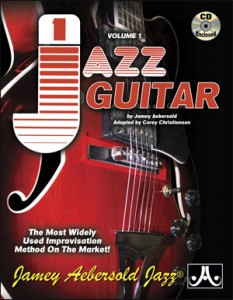Melodic Development-Tension & Release
The ultimate goal of music is to communicate to the listener
When improvising, using the notes of any given scale can usually keep things interesting… to a point. When playing melodies of any kind, both performers and listeners find that the creation of tension, and the release of that tension, makes for more interesting music.
“Tension” is anything that builds intensity or excitement in music. It could be a change in volume, use of leading tones, duration of notes played, silence, or many other elements.
However, you shouldn’t overuse tension in your playing. It’s like the garlic of the musical world. If you use too much, it’s overpowering and nasty. But, when used sparingly, it can make your music delicious. I mean food… it can make your food delicious. Tension is the same way.
An improvised solo should work itself to a tension filled climax, and then release to a finish. When you listen to skillful jazz players, they will often construct solos and melodies with back-to-back tension and release sections to tie them together.
The Golden Mean
The diagram above, and the ones that Jamey uses on page 71 of Volume 1, show the “direction” that an optimal solo using tension and release will look like. This ratio of approximately 2/3 is known as the Golden Mean (also known as the Golden Ratio, Fibonacci Numbers, or the Divine Ratio), and is used in all types of art forms and can be expressed mathematically as well. Obviously, a ratio is used differently in visual arts, architecture, or music. In music, it’s usually a length of time. Most songs hit their musical climax 2/3 through the tune, or a solo will reach max tension 2/3, and so on. Most people find things that adhere to this ratio to be inherently beautiful. The Golden Mean has been used throughout history to find the most aesthetically pleasing shapes. The Pyramids in Egypt and the Parthenon in Ancient Greece were built using the Golden Mean. Plants naturally adhere to this ratio as the most efficient way to grow. Even the construction of the human body has many visible examples of the Golden Mean. Observe the length between finger tip to elbow and length between wrist and elbow, or the length of the face and width of the face. I know you tried at least one of those measurements! While this information is not in Volume 1, it’s something I studied in my music history classes. I believe that knowing the past helps us going into the future.
One of the simplest things that I have done in my own playing is to play my solo/riff, what-have-you, and then use the leading tone 7th to bring me back to the tonic. Often I will increase the intensity (physically) of my playing at the end of a solo, and drop off suddenly. Neither of these techniques are hard or complex, but they add a little bit of interest to the end of these lines and usually sound fairly good. Every time you use tension, it should feel like it’s going somewhere. Ideally, each line should sound new and more exciting than the last. Imagine you’re telling a dramatic tale with your instrument. You want it to keep getting better and better.
Improvisors should keep in mind the traditional musical sequence, which is as follows: Statement Of Theme >> Development Of Theme >> Climax >> Release (Relaxation of Tension)
Elements Which Produce Tension
- Increased Volume
- Ascending Lines
- Emphasis On Passing Tones (non-chord/scale tones)
- Extreme Register Of Instrument
- Wide Intervals (especially ascending)
- Repetition (of almost anything)
- Alternating Directions
- Jagged Articulations
- Non-Chord Tones (4ths, 6ths, 7ths, & 9ths)
- Dramatic Devices (swoops, glissandos, shakes, trills, etc.)
- Dissonant Harmony
Elements Which Produce Release (Relaxation)
- Decreased Volume
- Descending Lines
- Notes of Longer Duration (quarter-notes, half-notes, whole-notes)
- Rests (space)
- Smoothness (legato)
- Emphasis On Chord Tones (root, 3rd, or 5th)
- Silence
- Consonant Harmony
It helps to know in advance when and where you want the melodic line to go. You can use tension and release to help get you to your musical destination.
Points To Keep In Mind When Improvising
- Music is communication – improvisation is a special way of communicating.
- Don’t play everything you know in every solo.
- Listen to yourself play – develop the idea you just played!
- Does your playing contain too much tension – too much release?
- Would you ramble on with words the way you do with notes? (My parents, professors, and employers would probably say, “Yes”)
- Every time you improvise you have a chance to say something. Do you?
- We can usually remember what we just said (verbally). Can you remember what you just played musically?
- Your instrument is merely a means of delivering the thoughts of your mind.
- Make your melodic lines SING through your instrument.
Conclusion
This blog post will conclude my four week study of Volume 1 for Jazz Guitar. In no way am I implying that I have mastered everything in the book that I’ve talked about, or even that I’ve written about everything in the book! This was a quick sprint into the marathon that is learning jazz music.
Hopefully my introduction into jazz guitar has interested, entertained, or amused you (all of thee above?). Click here to order your own Volume 1 for Jazz Guitar.
Until the next post! Keep practicing!
Coming soon: “How To Listen To Jazz” by Jerry Coker

